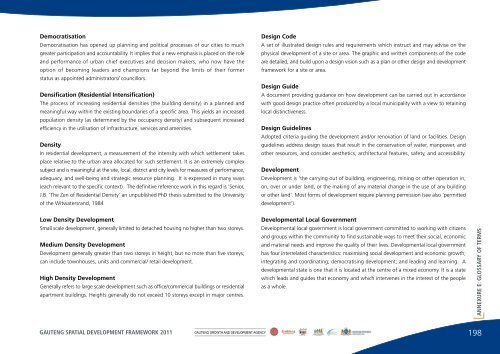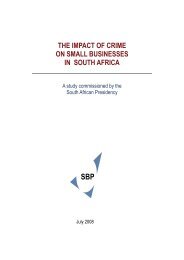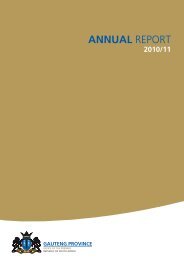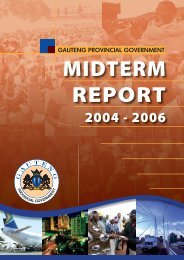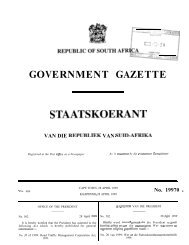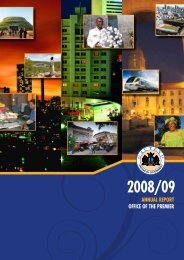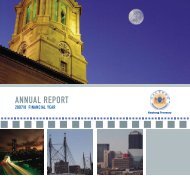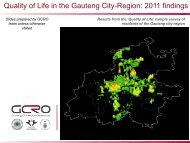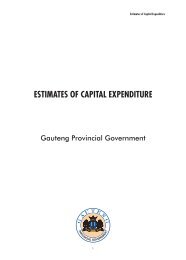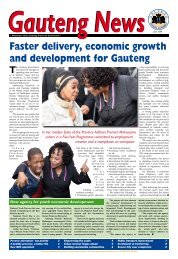the gauteng spatial development framework - Gauteng Online
the gauteng spatial development framework - Gauteng Online
the gauteng spatial development framework - Gauteng Online
You also want an ePaper? Increase the reach of your titles
YUMPU automatically turns print PDFs into web optimized ePapers that Google loves.
DemocratisationDemocratisation has opened up planning and political processes of our cities to muchgreater participation and accountability. It implies that a new emphasis is placed on <strong>the</strong> roleand performance of urban chief executives and decision makers, who now have <strong>the</strong>option of becoming leaders and champions far beyond <strong>the</strong> limits of <strong>the</strong>ir formerstatus as appointed administrators/ councillors.Densification (Residential Intensification)The process of increasing residential densities (<strong>the</strong> building density) in a planned andmeaningful way within <strong>the</strong> existing boundaries of a specific area. This yields an increasedpopulation density (as determined by <strong>the</strong> occupancy density) and subsequent increasedefficiency in <strong>the</strong> utilisation of infrastructure, services and amenities.DensityIn residential <strong>development</strong>, a measurement of <strong>the</strong> intensity with which settlement takesplace relative to <strong>the</strong> urban area allocated for such settlement. It is an extremely complexsubject and is meaningful at <strong>the</strong> site, local, district and city levels for measures of performance,adequacy, and well-being and strategic resource planning. It is expressed in many ways(each relevant to <strong>the</strong> specific context). The definitive reference work in this regard is 'Senior,J.B. 'The Zen of Residential Density' an unpublished PhD <strong>the</strong>sis submitted to <strong>the</strong> Universityof <strong>the</strong> Witwatersrand, 1984Design CodeA set of illustrated design rules and requirements which instruct and may advise on <strong>the</strong>physical <strong>development</strong> of a site or area. The graphic and written components of <strong>the</strong> codeare detailed, and build upon a design vision such as a plan or o<strong>the</strong>r design and <strong>development</strong><strong>framework</strong> for a site or area.Design GuideA document providing guidance on how <strong>development</strong> can be carried out in accordancewith good design practice often produced by a local municipality with a view to retaininglocal distinctiveness.Design GuidelinesAdopted criteria guiding <strong>the</strong> <strong>development</strong> and/or renovation of land or facilities. Designguidelines address design issues that result in <strong>the</strong> conservation of water, manpower, ando<strong>the</strong>r resources, and consider aes<strong>the</strong>tics, architectural features, safety, and accessibility.DevelopmentDevelopment is '<strong>the</strong> carrying out of building, engineering, mining or o<strong>the</strong>r operation in,on, over or under land, or <strong>the</strong> making of any material change in <strong>the</strong> use of any buildingor o<strong>the</strong>r land'. Most forms of <strong>development</strong> require planning permission (see also 'permitted<strong>development</strong>').Low Density DevelopmentSmall scale <strong>development</strong>, generally limited to detached housing no higher than two storeys.Medium Density DevelopmentDevelopment generally greater than two storeys in height, but no more than five storeys;can include townhouses, units and commercial/ retail <strong>development</strong>.High Density DevelopmentGenerally refers to large scale <strong>development</strong> such as office/commercial buildings or residentialapartment buildings. Heights generally do not exceed 10 storeys except in major centres.Developmental Local GovernmentDevelopmental local government is local government committed to working with citizensand groups within <strong>the</strong> community to find sustainable ways to meet <strong>the</strong>ir social, economicand material needs and improve <strong>the</strong> quality of <strong>the</strong>ir lives. Developmental local governmenthas four interrelated characteristics: maximising social <strong>development</strong> and economic growth;integrating and coordinating; democratising <strong>development</strong>; and leading and learning. A<strong>development</strong>al state is one that it is located at <strong>the</strong> centre of a mixed economy. It is a statewhich leads and guides that economy and which intervenes in <strong>the</strong> interest of <strong>the</strong> peopleas a whole.ANNEXURE E: GLOSSARY OF TERMSGAUTENG SPATIAL DEVELOPMENT FRAMEWORK 2011GAUTENG GROWTH AND DEVELOPMENT AGENCY198


